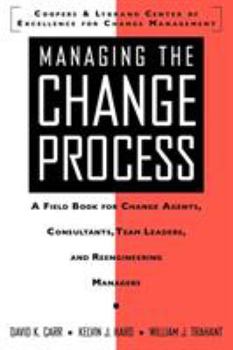Managing the Change Process: A Field Book for Change Agents, Team Leaders, and Reengineering Managers
Select Format
Select Condition 
Book Overview
Explains the global changes confronting business leaders. This book includes strategies for managing major change, creating an organizational culture conducive to change, and leading change... This description may be from another edition of this product.
Format:Paperback
Language:English
ISBN:0070129444
ISBN13:9780070129443
Release Date:October 1995
Publisher:McGraw-Hill
Length:272 Pages
Weight:1.25 lbs.
Dimensions:1.0" x 6.2" x 9.3"
Customer Reviews
3 ratings
A Bit Dated, but Still Useful
Published by Thriftbooks.com User , 16 years ago
I wouldn't really call this a "field book," but it is certainly a good account of organization change management. It comes out of the mid-90s, so its orientation is toward the learning organization (Senge) and business process reengineering (Hammer and Champy). An update would doubtless align itself behind Balanced Scorecard (Kaplan and Norton). If you have any background at all in strategic planning or workflow analysis, you will find the basic concepts familiar and usefully applied. The core observations make sense: * Change is an ongoing reality of the modern enterprise, and so is change management. * Change management must involve both the technical side and the people side of the organization. * Managing change starts with planning, but planning isn't sufficient, so don't get bogged down. * The leaders of change are the leaders of the organization: top management. Of course, they must commit to the change, but, more importantly, they must show their commitment in their behavior. They must be the managers that they need to be if the change is to be successful, and they must actively involve themselves in selling the change to the troops. * Change management must incorporate metrics, especially on the people side, so you can know if you're making progress. Etc. There are lots of lists that can usefully be turned into checklists, and there is an appendix of excerpts from interviews with change leaders. The negatives aren't really serious. The C & L methodology is so general as to be either obvious or useless, depending on your point of view. C & L doesn't share its tools, but it does name them, so you should be able to find some that are functionally comparable. In sum, this is a good starting point for building a change management function and/or understanding your role in the process.
A useful, handy & concise reference book.
Published by Thriftbooks.com User , 23 years ago
A very useful book especially if you are a change agent within your corporation. In relatively short and sharp chapters, the three authors address key issues in managing change. The underlying theme that change is all about people comes out relatively clearly. Though the book is based on much of Coopers & Lybrand's approach to change management, the first six chapters are fairly generic. By learning from the Coopers & Lybrand's experiences , you can craft your appropriate change strategy for your particular situation and circumstances. Recommended reading for all those involved in managing change and transition at the workplace.
An important contribution
Published by Thriftbooks.com User , 24 years ago
An important contribution to a critical subject. Change management consulting often suffers from "hack" approaches. Whether change can in fact be managed is another issue.





